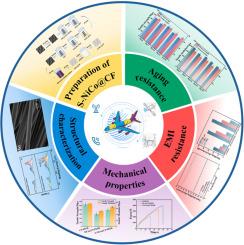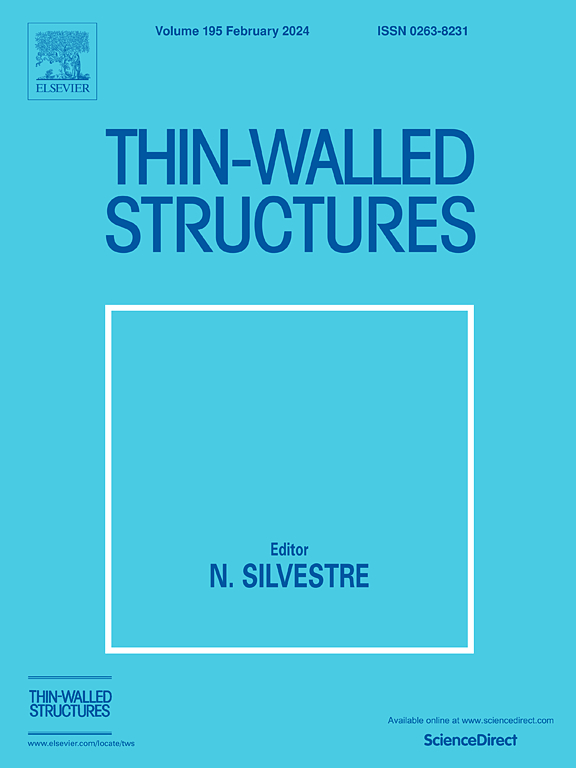Enhancing the electromagnetic shielding and mechanical properties of CF/PEEK composites via low-concentration fluff and Ni-Co alloy plating
IF 5.7
1区 工程技术
Q1 ENGINEERING, CIVIL
引用次数: 0
Abstract
Carbon Fiber Reinforced Composites (CFRC) are increasingly used in aircraft to minimize weight and maximize structural designability. However, CFRCs have limitations in electrical conductivity and Electromagnetic Interference (EMI) resistance. This study introduces a process to overcome these drawbacks by chemically plating Carbon Fiber (CF) fabrics with a thin layer of Nickel-Cobalt (Ni-Co) alloy, thereby improving electrical conductivity. Subsequently, Sulfonated Polyether Ether Ketone (SPEEK) was applied to the Nickel-Cobalt coated Carbon Fibers (NiCo@CF). The resulting fuzzy surface effectively enhanced the interfacial interactions within the PEEK matrix. The results showed that the tensile strength, tensile modulus, flexural strength, and flexural modulus of the composite panels treated with 0.1 wt.% SPEEK sizing significantly increased by 32.3 %, 26.0 %, 167.9 %, and 20.7 %, respectively, compared to NiCO@CF/PEEK composite panels treated with no SPEEK sizing agent. Additionally, the introduction of SPEEK fostered a shift in the primary fracture mechanism from fiber pull-out or debonding to fiber fracture. Remarkably, compared to CF/PEEK composites, the electromagnetic shielding efficiency of NiCo@CF/PEEK was increased by 88.98 %, reaching 46.15 dB. Long-term testing of the S-NiCO@CF/PEEK composites in a humid and hot environment confirmed consistent electromagnetic and mechanical properties, alongside good fatigue and aging resistance. These advances make the S-NiCO@CF/PEEK composites promising for broader applications in the aircraft and aerospace fields.

通过低浓度绒毛和镍钴合金电镀增强 CF/PEEK 复合材料的电磁屏蔽和机械性能
碳纤维增强复合材料(CFRC)越来越多地用于飞机,以最大限度地减轻重量和提高结构可设计性。然而,碳纤维增强复合材料在导电性和抗电磁干扰(EMI)方面存在局限性。本研究介绍了一种克服这些缺点的工艺,即在碳纤维(CF)织物上化学镀一薄层镍钴(Ni-Co)合金,从而提高导电性。随后,将磺化聚醚醚酮(SPEEK)应用于镍钴涂层碳纤维(NiCo@CF)。由此产生的模糊表面有效增强了 PEEK 基体内部的界面相互作用。结果表明,与未使用 SPEEK 施胶剂处理的 NiCO@CF/PEEK 复合材料板相比,使用 0.1 wt.% SPEEK 施胶剂处理的复合材料板的拉伸强度、拉伸模量、弯曲强度和弯曲模量分别显著提高了 32.3 %、26.0 %、167.9 % 和 20.7 %。此外,SPEEK 的引入还促使主要断裂机制从纤维拉出或脱粘转变为纤维断裂。值得注意的是,与 CF/PEEK 复合材料相比,NiCo@CF/PEEK 的电磁屏蔽效率提高了 88.98%,达到 46.15 dB。在潮湿和高温环境中对 S-NiCO@CF/PEEK 复合材料进行的长期测试表明,其电磁和机械性能保持一致,并具有良好的抗疲劳和抗老化性能。这些进步使 S-NiCO@CF/PEEK 复合材料有望在飞机和航空航天领域得到更广泛的应用。
本文章由计算机程序翻译,如有差异,请以英文原文为准。
求助全文
约1分钟内获得全文
求助全文
来源期刊

Thin-Walled Structures
工程技术-工程:土木
CiteScore
9.60
自引率
20.30%
发文量
801
审稿时长
66 days
期刊介绍:
Thin-walled structures comprises an important and growing proportion of engineering construction with areas of application becoming increasingly diverse, ranging from aircraft, bridges, ships and oil rigs to storage vessels, industrial buildings and warehouses.
Many factors, including cost and weight economy, new materials and processes and the growth of powerful methods of analysis have contributed to this growth, and led to the need for a journal which concentrates specifically on structures in which problems arise due to the thinness of the walls. This field includes cold– formed sections, plate and shell structures, reinforced plastics structures and aluminium structures, and is of importance in many branches of engineering.
The primary criterion for consideration of papers in Thin–Walled Structures is that they must be concerned with thin–walled structures or the basic problems inherent in thin–walled structures. Provided this criterion is satisfied no restriction is placed on the type of construction, material or field of application. Papers on theory, experiment, design, etc., are published and it is expected that many papers will contain aspects of all three.
 求助内容:
求助内容: 应助结果提醒方式:
应助结果提醒方式:


